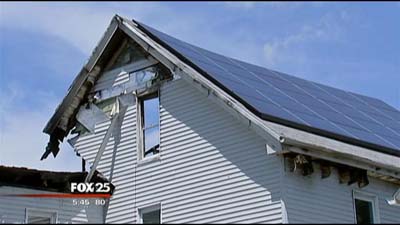(Boston News, Weather, Sports | FOX 25 | MyFoxBoston)

|
(Boston News, Weather, Sports | FOX 25 | MyFoxBoston)

BOSTON (MyFoxBoston.com) - More and more people are taking advantage of renewable energy powered by the sun and placing solar panels on their homes.
But during an emergency the dangers of solar panels are a growing concern to firefighters trying to save you.
�If you�re doing it for the first time it�s kind of an �oh what do I do now,�� Marlborough Fire Chief Geoffrey Herald said.
Firefighters in Marlborough recently responded to a fire in a home with panels. Chief Herald said that while the solar panels did not cause the fire, they can make fighting the fire a real challenge.
�Seeing that solar array does give us pause and make us aware of a couple other things we have to be aware of. In this particular case just shutting down the units was a different issue for us because we hadn�t seen these particular panels,� herald said. �Obviously the shock factor, the potential for injury for our firefighters is still there even though the power is shut off from the street.�
In direct sunlight solar panels can generate between anywhere between 200 and 600 volts of electricity. Because they generate electricity any time there is light they never power off.
�At 2 a.m. when we�re climbing up on the roof the sun is not shining, but when we turn our flood lights on the panel can still be generating power,� Herald said.
Ken Willette of the National Fire Protection Association in Quincy says solar panel training for firefighters is needed.
�There is not a lot of organized training that�s taking place and getting into every single firehouse across the county, that�s probably one of the gaps that we have right now,� he said.
Firefighters say with no national training standards in place, combating a house fire with rooftop solar panels is challenging, and can be very dangerous.
Fire Protection Research Foundation report: "Fire Fighter Safety and Emergency Response for Solar Power Systems"
Author: Casey C. Grant, P.E.
Date of issue: May 2010 (revised October 2013)
Foreword
Today's emergency responders face unexpected challenges as new uses of alternative energy increase. These renewable power sources save on the use of conventional fuels such as petroleum and other fossil fuels, but they also introduce unfamiliar hazards that require new fire fighting strategies and procedures.
Among these alternative energy uses are buildings equipped with solar power systems, which can present a variety of significant hazards should a fire occur. This study focuses on structural fire fighting in buildings and structures involving solar power systems utilizing solar panels that generate thermal and/or electrical energy, with a particular focus on solar photovoltaic panels used for electric power generation.
The safety of fire fighters and other emergency first responder personnel depends on understanding and properly handling these hazards through adequate training and preparation. The goal of this project has been to assemble and widely disseminate core principle and best practice information for fire fighters, fire ground incident commanders, and other emergency first responders to assist in their decision making process at emergencies involving solar power systems on buildings. Methods used include collecting information and data from a wide range of credible sources, along with a one-day workshop of applicable subject matter experts that have provided their review and evaluation on the topic.
Notice of Revision (October 2013): This report was revised in October of 2013. Changes other than editorial are indicated by a vertical rule beside the paragraph, table or figure in which the change occurred. These rules are included as an aid to the user in identifying changes from the previous edition. This report was issued in May 2010 and revised in October 2013. Changes have been made to the information on page 57 to address the hazards of PV at nighttime. The information described on page 57 for the electrical energy hazards of a PV system from other than sunlight (e.g., mobile lighting plant) were taken from citation 137 when this FPRF report was prepared in May 2010, which was the best information available at that time. Since then a subsequent separate study from Underwriters Laboratories has further clarified through empirical tests that a hazard may exist from non-sunlight sources, i.e., at nighttime. This UL report is "Firefighter Safety and Photovoltaic Systems" and was issued in November 2011, and is available through the UL website.
![]()
 |
 |
 |
 |
 To Kolb |
|---|